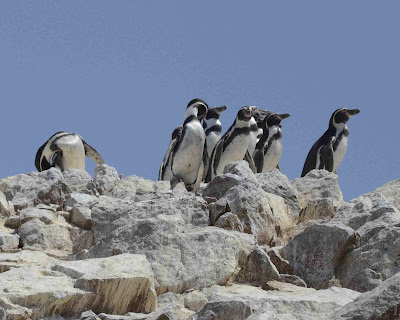This desert land is unlike any we have visited. It truly is desert, no plant growth visible. The iron red of the soil inspired Juan San Martin, the liberator of Peru to design the Peruvian flag in red and white.
Severe earthquakes have revealed fossils and mummies. Julio Cesar Tello, father of Peruvian archeology and a Harvard graduate, was America"s first indigenous archeologist. Mounds found under his guidance have yielded 429 mummies, a few of which we saw in Larco.
We took a boat ride on the Penguin V to Ballestas Island to view wildlife and geoglyphs.
This candelabra geoglyph is of a unknown origin, could be either an ancient or a modern creation. It is oriented due south. White minerals and guano create the red and white lines, the beige comes from clay and the black markings basalt. This drawing is 170 meters long and 70 meters wide.
We saw outstanding wildlife as we circled the island. A few blue footed boobies had flown in from the Galapagos Islands. A booby can dive down 60 meters into the sea to find food.
Humboldt penguins
Peruvian boobies and Cormorants provide the much needed guano for export as fertilizer.
This cormorant nest shot shows mother cormorant feeding her chick.
Males weigh about 300 kilograms. The females and babies are here from February to April.
These piers were used by guano collectors but now collecting is no longer legal.
The Humboldt Current that affects weather in California goes all the way down the South American coast. The changing weather effects of El Nino are also felt here.













No comments:
Post a Comment